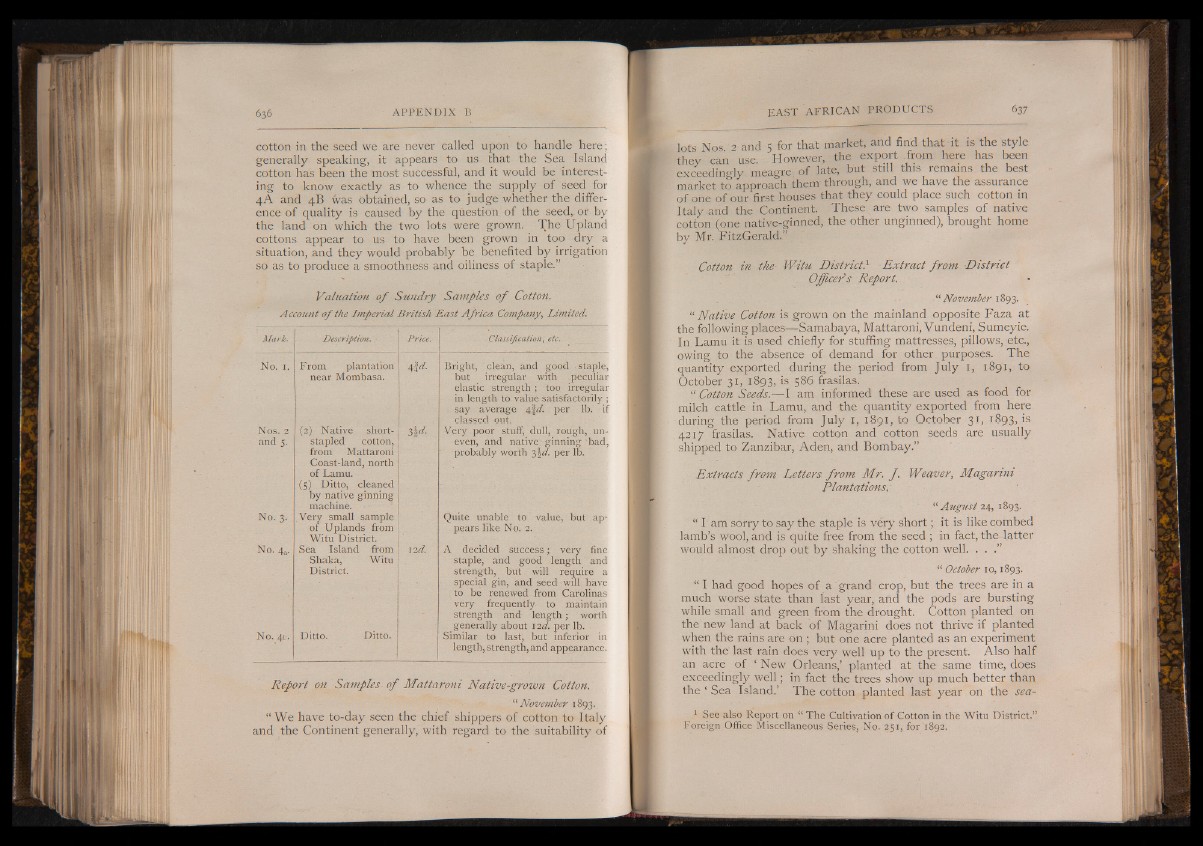
cotton in the seed we are never called upon to handle here;
generally speaking, it appears to us that the Sea Island
cotton has been the most successful, and it would be interesting
to know exactly as to whence the supply of seed for
4A and 4B was obtained, so as to judge whether the difference
of quality is caused by the question of the seed, or by
the land on which the two lots were grown. The Upland
cottons appear to us to have been grown in too dry a
situation, and they would probably be benefited by irrigation
so as to produce a smoothness and oiliness of staple.”
Valuation o f Sundry Samples o f Cotton.
Account o f the Imperial British East Africa Company, Limited.
Mark. Description. Price. - Classification, etc.
No. I. F rom plantation
near Mombasa.
4f d. Bright, clean, and good .staple,
but irregular with peculiar
elastic strength ; too irregular
in length to value satisfactorily ;
say average 4fd. per lb. if
classed out.
Nos. 2 (2) Native short- 3 id - Very poor stuff, dull, rough, unand
5. stapled cotton,
from Mattaroni
Coast-land, north
of Lamu.
(5) Ditto, cleaned
by native ginning
machine.
even, and native'rginning 'bad,
probably worth 3\d . per lb.
No. 3. Very small sample
of Uplands from
Witu District.
Quite unable to value, but appears
like No. 2.
No. 4a. Sea Island from
Shaka, Witu
District.
12 d. A decided success; very fine
staple, and good length and
strength, but will require a
special gin, and seed will have
to be renewed from Carolinas
very frequently, to maintain
strength and length; worth
generally about 12d. per lb.
No. Mi Ditto. Ditto. Similar to last, but inferior in
length, strength, and appqarance.
Report on Samples■ o f Mattarpni Native-grown Cotton.
“ November 1893..
“ We have to-day seen the chief shippers of cotton to Italy
and the Continent generally, with regard to the suitability of
lots Nos 2 and 5 for that market, and find that it is the style
they can use However, the export from here has been
exceedingly meagre, of late, but still this remains the best
market to approach them' through, and we have the assurance
of one of our first houses that they could place such cotton in
Italy and the Continent. These are two samples of native
cotton (one native-ginned, the other unginned), brought home
by Mr. FitzGerald.”
Cotton in the- Witu District} Extract from District
Officer’s Report.
“ November 1893.
“ Native Cotton is grown on the mainland opposite Faza at
the following places— Samabaya, Mattaroni, Vundeni, Sumeyie.
In Lamu it is used chiefly for stuffing mattresses, pillows, etc.,
owing to the absence of demand for other purposes. The
quantity exported during the period from July 1, 1891, to
October 31, 1893, is 586 frasilas.
“ Cotton Seeds.— I am informed these are used as food for
milch cattle in Lamu, and the quantity exported from here
during the period from July 1, 1891, to October 31, 1893, is
4217 frasilas. Native cotton and cotton seeds are usually
shipped to Zanzibar, Aden, and Bombay.”
Extracts from Letters from Mr. f . Weaver, Maganni
Plantations,
I August 24, 1893.
“ I am sorry to say the staple is very short; it is like combed
lamb’s wool, and is quite free from the seed ; in fact, theTatter
would almost drop out by shaking the cotton well. . .
“ October 10,1893.
“ I had good hopes of a grand crop, but the trees are in a
much worse state than last year, and the pods are bursting
while small and green from the drought. Cotton planted on
the new land at back of Magarini does not thrive if planted
when the rains are on ; but one acre planted as an experiment
with the last rain does very well up to the present. Also half
an acre of ‘ New Orleans,’ planted at the same time, does
exceedingly well; in fact the trees show up much better than
the ‘ Sea Island.’ The cotton planted last year on the sea-
1 See also Report on “ The Cultivation of Cotton in the Witu District.”
Foreign Office Miscellaneous Series, No- 251, for 1892.